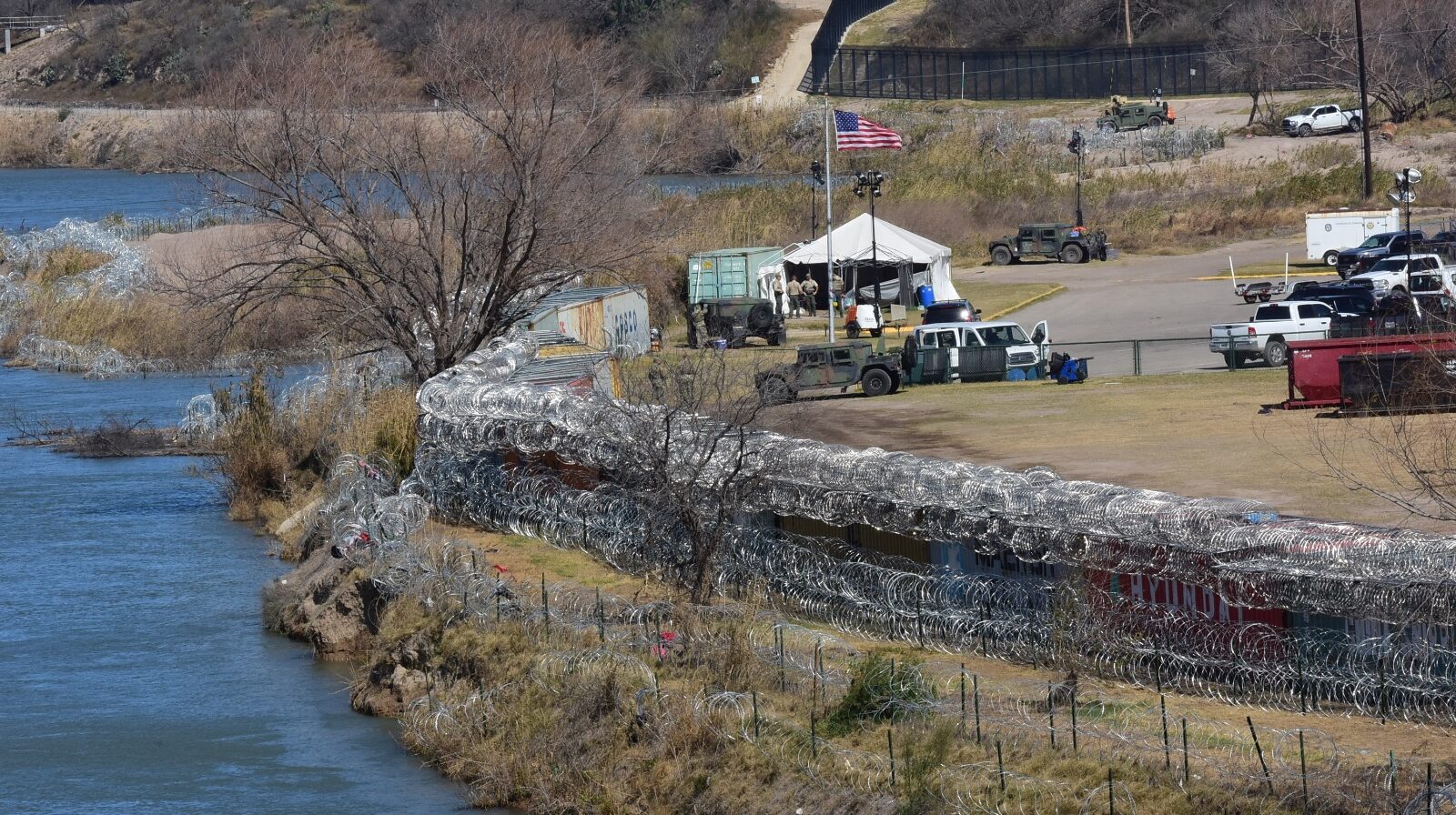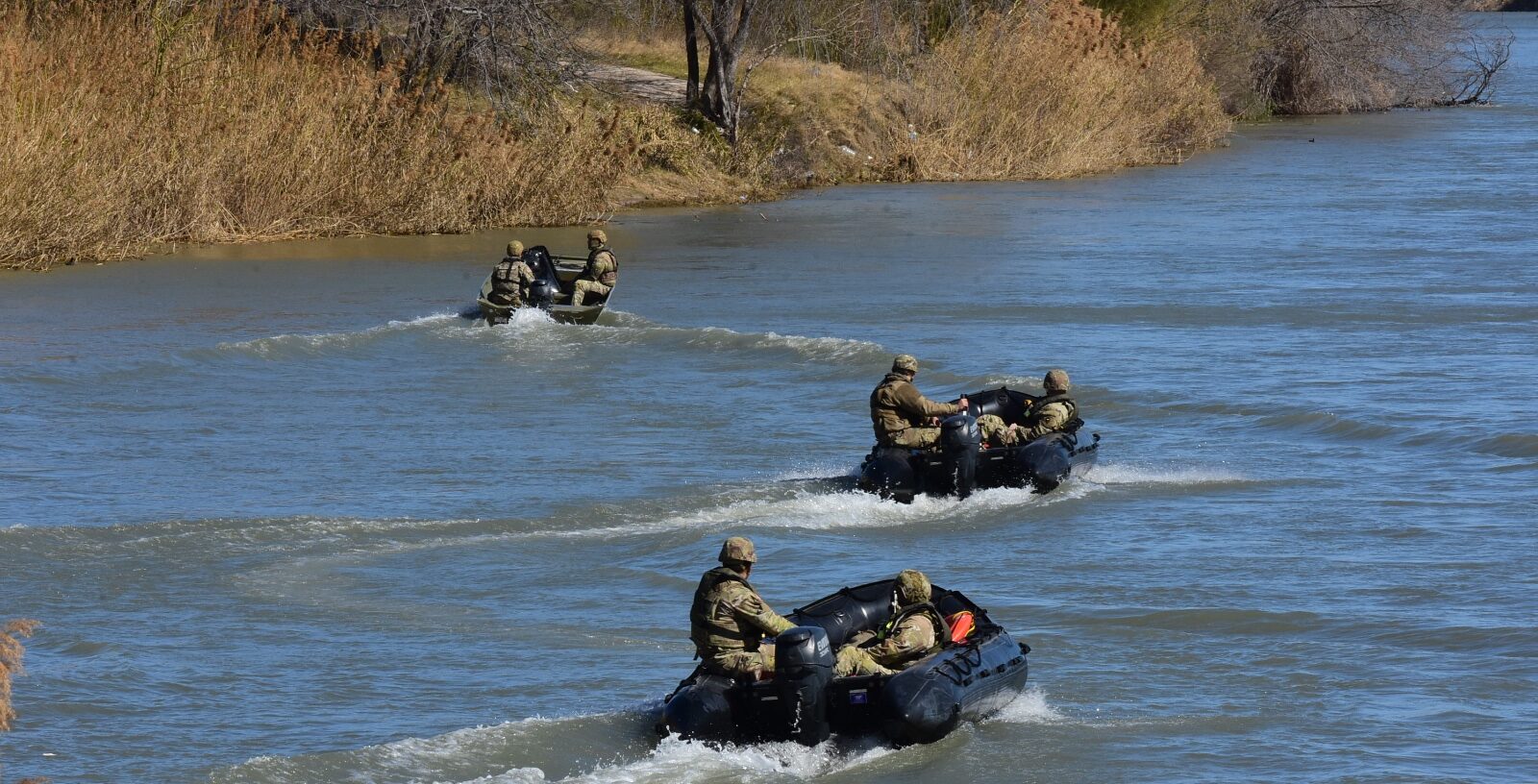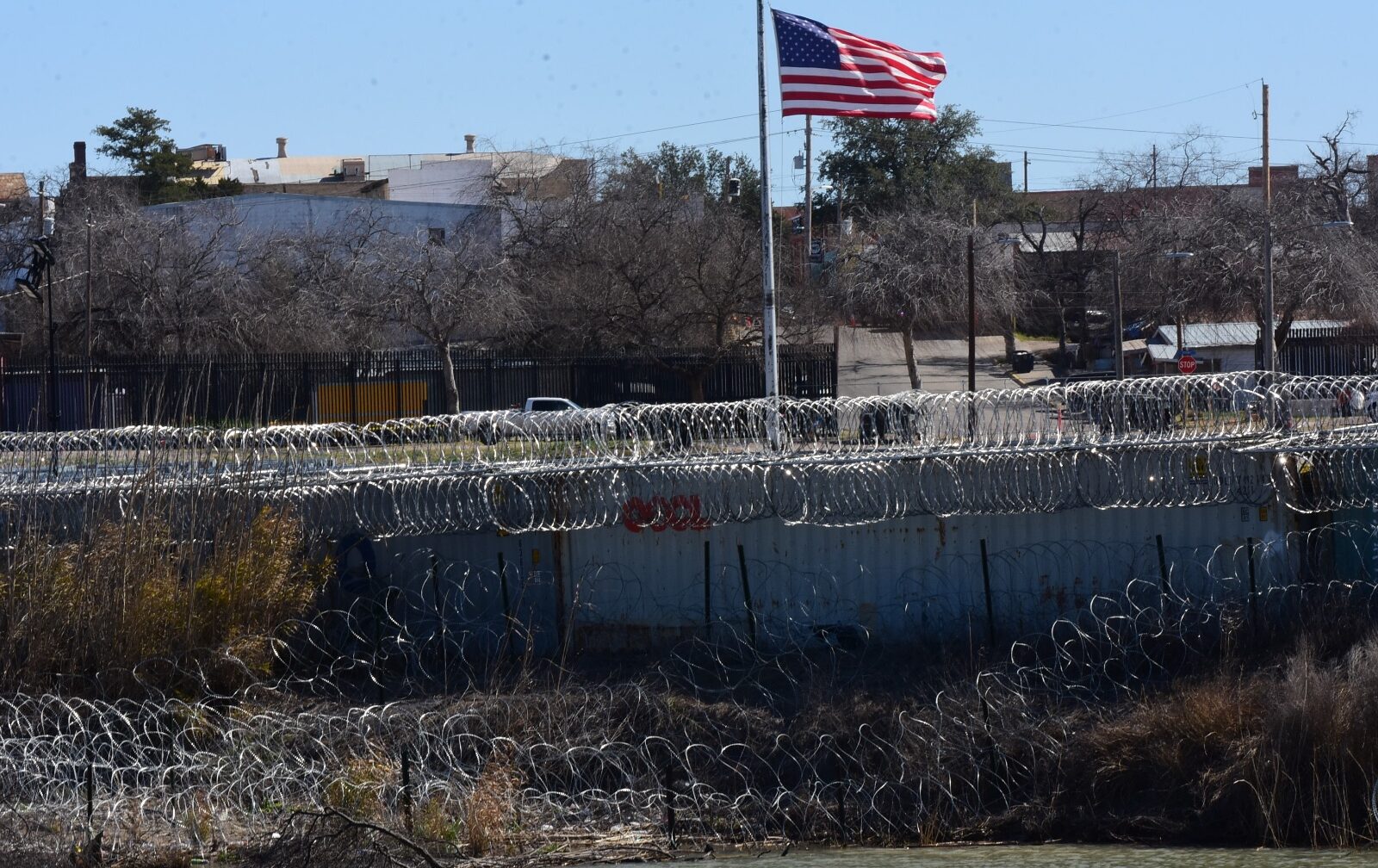The Rio Grande is shallow, but wields a powerful current where it slices sharply between the small windy Texan city of Eagle Pass on its northern bank and the larger Mexican city of Piedras Negras — Black Stones, after its coal deposits — on its southern. On the two banks, there are contrasting scenes. On the Mexican side, soldiers are dotted every few hundred yards along a track where locals walk dogs and jog by the bank. On the American, you see layers of razor wire, green Humvees and old cargo train carriages piled into barricades.
Over the past month, this small stretch of river has turned into the symbolic ground zero of the US battle over the border and immigration, the central issue of a contentious election year. But its fault lines extend well beyond these waters. This is also the epicentre of the problems that have dogged both America and Mexico for years: drug cartel money, the exodus from crumbling regimes and an existential struggle over the identity of the United States itself.
In December, Border Patrol agents processed more than 71,000 migrants and asylum seekers who crossed the river into the Del Rio sector, which includes Eagle Pass. They formed part of a record number of more than 300,000 migrants processed along the entire border in that month. In response, on January 10, Texas Governor Greg Abbott ordered his state National Guard (a section of the army under the governor’s control) to fortify Shelby Park, a 47-acre patch of scrubby land by the river.
In a historical irony, the park is named after a Confederate general who fled to Mexico rather than surrender to the Union in the Civil War. When the Biden White House ordered that Border Patrol agents be let into Shelby, Abbott refused, setting up a stand-off between the state and federal powers over who polices the border. The Texas governor has also clashed with Washington over the use of razor wire, which the federal government argues is unnecessary and harmful. Activists of the Right have sided with Abbott: hundreds declared they would lead a convoy to support Texas and “take our border back”.
Travelling in from Mexico City, I arrive in Piedras Negras on a Friday night to find a rainy and windy Rio Grande, and meet Benicio Herrera, a hardware store owner walking his Labrador along the bank. When I ask about the fortifications on the US shore, he shrugs his shoulders. “There are two sides to this,” he says. “On one hand, the migrants have human rights. But on the other, we have never seen numbers like this before so there is going to be a reaction.”

Opinions on the migrant surge in Mexico are mixed. Over in a park by the bridge into the US, I talk to Cipriano Arguello, who’s selling potato chips and chicharrón (pork rinds), who is sympathetic to those crossing. “People forget where they have come from,” he says. “We are all migrants.” Watching over his juice stand in a nearby market, however, Francisco Vázquez says he supports the hardened measures. “They have to implement tactics for security,” he says. “They should have done this a long time before.” The Piedras Negras residents also have varied opinions on the convoy of activists making their way to Texas. Some refer to them as “patriotas” or “patriots”, while others label them the “anti-migrants”.
These mixed feelings reflect how migration over the US border has transformed in the last decade. The vast majority going over used to be Mexicans, sneaking in between the official bridges to find work. But now Mexicans make up less than a quarter, with the rest coming from around the globe, particularly Venezuela and Honduras, but also South Africa, China and Russia. Most of them enter Mexico through its southern border, before trekking through the cities and countryside to the north.
On the Saturday morning, I visit the Casa de Migrante, a Catholic shelter where migrants can get a bed. Sitting on the sidewalk, Francisco Lugo tells me how he fled Venezuela with his wife and four children, after he was threatened by a government-linked militia demanding money. He wants to apply for asylum, but like many plans to cross the river and make his application in the United States. Lugo knows nothing about the convoy but has heard about a military build-up. “God will help me find a good time when the water is low and we can go over the river,” he says.
Later, a Cuban man arrives at the hostel and reveals he had been kidnapped. A mechanic by trade in his late 20s, Minardo Escalona describes how he was abducted in the city of Monterrey, taking a taxi which handed him to the gangsters. He was kept for three days until his family in Cuba sent $2,000 by Western Union. “They give you scraps to eat, just to keep you alive to pay,” he says. “I’m glad I made it but I feel terrible that my family had to lose all that money.”
Gangsters, usually affiliated to the cartels, have been kidnapping migrants in Mexico for over a decade, but there has been an uptick in cases. It’s an especially cruel crime: wrenching money from the poorest and most desperate. But human smuggling in Mexico is a bloody and ever-evolving racket. In the Eighties, the smugglers, known as polleros or chicken herders, were local players who would take migrants over the border for a couple of hundred dollars. As the fences got higher and demand got bigger, networks have formed that stretch from American cities and down into Latin America. A Central American can now expect to pay about $15,000 to go from their home all the way to their destination in Chicago or San Francisco. The human smugglers work with the cartels, and that price buys immunity from kidnapping (or so they hope). Those who can’t afford or don’t want to pay, risk getting nabbed.
While cartels control most of the Mexican border, Piedras Negras is in the state of Coahuila, which has a heavily armed police force that has chased out the remnants of the Zetas cartel. However, Isabel Turcios, a nun who runs the hostel, says the police have simply taken over the business of shaking down migrants themselves. “They hunt them down and they get every peso they can from them,” she said. “It’s terrible.” I ask Turcios about the convoy and the barbed wire. “There are women and children crossing,” she says. “Why do they keep giving these people the incentive to go north and then punish them for it?”
As Saturday heats up, I go to the river and see the Texas National Guard speeding up and down on boats, each manned by two soldiers. I talk to a group of their Mexican opposite-numbers watching from the south side. An officer tells me their instructions can vary on whether to arrest migrants or let them through, but in recent weeks they have been working hard to round them up. “We do the work of containment of the migrants,” he says. “I feel bad detaining these people looking for a better life but that is what our orders are.”
These Mexican efforts are a large part of the reason that there are not many migrants actually crossing this weekend, as activists, cameras and politicians descend on the area. In January, US border authorities processed 176,000 migrants, a big drop from December although still a high number. But the pressure has not disappeared: there are already reports that, since the start of February, the migrant flows have shifted to the parts of the border in Arizona and California.

A decisive solution remains elusive. The successive governments of Obama, Trump and now Biden have all worked to get Mexico to slow down the migrant flow using a range of incentives and threats, but the crisis has only grown. And last week, this cooperation was threatened by a tangential matter. Three media outlets, including the investigative organisation ProPublica, released stories relating to an old Drug Enforcement Administration probe into a cartel that allegedly financed the 2006 election campaign of Mexican President Andrés Obrador. The President reacted angrily, accusing the US State Department of plotting against him, and said this could threaten how Mexico was containing the migrants. Biden was forced to personally call Obrador and made clear the two were “committed to continuing their productive partnership”.
Thus the situation on the ground remains critical but stable. Travelling with Mexican investigative journalist Juan Alberto Cedillo, I head north of Piedras Negras. As we trek along a dirt path, a police car speeds over to check who we are. We show our press IDs and move on. While Juan holds back, I head further into the hills and see a movement in the trees. Walking into the woodland, I spot the khaki of uniforms and see two soldiers crouched with a dog and their guns.
Unlike the troops in town, they aren’t friendly. They demand I hand over my phone and, when I refuse, they threaten to set the dog on me. They are tense, looking through my phone and accusing me of making a call to give their location away. When Juan rings, they put him on speaker and I say I am being detained. He quickly alerts a group of journalists who keep an eye on security. Eventually, the soldiers check by radio and confirm I’d been checked out by the police. I am allowed to walk away.
Early the following day, I make the journey everyone is here for, crossing the bridge into Eagle Pass and the United States. The convoy to “take our border back” had been staying at a ranch north of the city. There were reportedly a few hundred attendees, far fewer than some had hoped, or feared, and no violence. There had been similar, smaller convoys to Yuma, Arizona and San Ysidro, California. Governor Abbott, along with 13 other Republican governors, is holding a press conference inside Shelby Park but the convoy members aren’t allowed in. Most have headed home but there are still a few in downtown Eagle Pass.
Many of the convoy members are retirees in their 70s, and don’t at all fit the profile of ferocious MAGA insurrectionists. I talk for a long while with a 73-year-old Vietnam veteran from Texas and Frank Lite, a 60-year-old businessman from Tennessee. They are both strong conservatives, and say that while they are fine with legal immigration, the border needs to be secured. And they enthusiastically support the Texas governor’s taking the park, “1,000%,” as Lite puts it. “He should have done this three years ago.”
Walking down the street, I talk to another group of retirees from the convoy, including a former airplane mechanic and his school teacher wife who drove a thousand miles from Florida, picking up others on the way. They all seem in a festive mood and talk about meeting good Christians while protesting to close the border. Outside Shelby Park itself, there is a counter-demonstration of activists protesting the National Guard’s seizure of the park. “Our river, our land,” says one banner. “Trump for prison,” says another. An elderly member of the convoy in a wheelchair lightly heckles them from across the road.
Jesse G. Herrera, 70, a retired poet in the counter-protest, says the park should be used by the residents. “It’s a city park. It’s not a state park. It’s not a federal park. It belongs to the people.” When I ask about the razor wires, he is dismissive. “It’s a waste of money. It’s not doing anything, it’s a joke. It’s political theatre.” Inside the park itself, TV crews are getting ready to film the governors. I find Jacob Tackett, an army veteran of Afghanistan from Virginia, and Nolan Meeks, who works for a body armour company in California. They flew down to document the event, thinking it would be far bigger.
Tackett said he was especially keen to verify the claims of whether there was a genuine stand-off between federal and state forces. And, after speaking to the troops, he said the reality was far more peaceful than reports made out. “The most poignant quote I got was from a company commander. His phrase was: ‘If you look at our Humvees, none of them have guns mounted on the trucks. What does that tell you?’” The supposed militarisation of the border is clearly an exaggeration, Tackett says. “If there were a stand-off, there would be guns mounted on trucks. And clearly that isn’t the situation. Clearly, the federal authorities were happy to have the assistance.”

Before the politicians arrive, the troops set up a backdrop in front of the river with Humvees and soldiers and barbed wire. The 14 governors arrive in a convoy of armoured vehicles, and then give short speeches that are live-streamed on Facebook. “Now that we have taken control of this area, for the past three days, there is an average of only three people crossing illegally in this area,” Abbott says. I walk back into Mexico along with Tackett and Meeks and watch the rest of the governor press conference from the Mexican side.
Looking down on Shelby Park, you can see what a small section of border it represents. Whatever Abbott has achieved here is no gamechanger. Tackett says that seeing the border for himself shows how much both sides distort the issue for their bases. “It’s very clearly a dog and pony show to drive donations,” he says. “There is a corrupted incentive structure from the conservative side of the house not to fix the problem either… The migrants themselves are the currency.”
Having spent two decades covering America’s southern border with Mexico, it’s hard to disagree with him. Forces deep within their political and economic systems lack the will or ability to solve an overwhelming problem, yet know fully well how it can be deployed to make hay on the airwaves. The result isn’t just a setting for hope and tragedy — but a stage for political theatre.
Disclaimer
Some of the posts we share are controversial and we do not necessarily agree with them in the whole extend. Sometimes we agree with the content or part of it but we do not agree with the narration or language. Nevertheless we find them somehow interesting, valuable and/or informative or we share them, because we strongly believe in freedom of speech, free press and journalism. We strongly encourage you to have a critical approach to all the content, do your own research and analysis to build your own opinion.
We would be glad to have your feedback.
Source: UnHerd Read the original article here: https://unherd.com/


